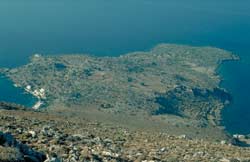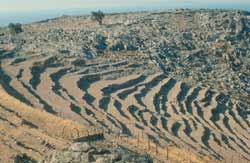Environmental Evidence
The importance of local environment
One of the goals of archaeology is to understand human interaction with landscapes. It is therefore crucial to understand local environments, literally from the ground up - geology, soils, minerals, water sources, climate, flora, and fauna.
A good starting-point is to investigate the present environment, and how people interact with it; knowledge of 'now' is particularly important for archaeologists working outside their home territory.
It is also crucial to realise that past environments may have been different. Seemingly small variations between now and then can result in significant differences.
Three examples will show how environmental evidence can help us to reconstruct the past.
Example 1: Neolithic Crete

Dwarf elephant and hippo of Malta beside modern elephant.
© Collins |
In the Pleistocene, before people arrived, there were no carnivores on Crete. As on many islands in the Mediterranean, all the animals were herbivores. Without predators, there was no need for size differentiation (large to intimidate, small to run away) so animals had begun to converge in size. On Crete there were pygmy hippos and giant dormice!
We know about these animals from their fossils remains. We know about the impact of 'unbothered' herbivores from the huge number of endemic plant species with special adaptations to avoid being eaten. We also believe that the climate was somewhat warmer (hence the hippo). At some point, people arrived on Crete, and it is thought that humans were responsible for the disappearance of the size-convergent herbivores, otherwise known as 'The Pleistocene Extinctions'.
At the very end of the Neolithic period, the climate on Crete was warmer and wetter than it is today. Information from ancient pollen, dated by radiocarbon, tells us that species which today do not occur together on Crete did grow near each other in the fifth-fourth millennia BC - the olive tree (in process of being domesticated), and trees now confined to northern Europe, e.g. the lime tree or linden (Tilia, not the citrus species).
After the Neolithic, the climate became more or less like that of today, though there has been at least one major 'cold' period since then (the Little Ice Age around the seventeenth century AD).
Example 2: Roman Sphakia

Phoinix-Loutro: Loutro harbour on left; Ag. Kharalambos church on point; mill inland left of centre; grey patch on right is ancient, raised W harbour; disused terraces; Phoinikas on right. Looking S. July 1989.
© Sphakia Survey |
In the Late Roman period, there was a major change in sea level that affected the only winter harbour on the south coast of Crete, at Loutro (ancient Phoenix). Loutro is on the side of a hammerhead peninsula. Throughout antiquity there had also been another, shallower harbour on the west side. After the Great Uplift (dated by radiocarbon: see Unit 1 Session 2 Lesson 3), the west harbour was no longer usable.
Example 3: 20th-21st Century Sphakia

Terraces due W of village of Livaniana. Looking S. July 1989.
© Sphakia Survey |
From the Neolithic until World War II, the backbone of the local economy was cultivation. Sphakia is a mountainous area with relatively little arable land. Agricultural terraces were built and used on suitable slopes.
After World War II, many people left Sphakia for cities elsewhere on Crete or on the Greek mainland; some left Greece altogether for Canada, the US or Australia. Once the terraces had been disused for several decades, there was no more vegetation to hold down the soil. Wind erosion blew the topsoil away, often revealing artefacts which we as archaeologists were delighted to find.
Required Reading
Please read Renfrew and Bahn, Archaeology: Chapter 6, ‘What was the environment? Environmental archaeology’. Please also read Insight Guide: Crete, pp 55-8 on geography and industry, 82-7, 161, 172-3, 222-3 on flora and fauna.
Further Reading
Author(s): Oliver Rackham, Jennifer Moody.
Title: The Making of the Cretan Landscape
Year: 1996
Publisher: Manchester University Press
Published in: New York
Alternate edition:
Author(s): Oliver Rackham, Jennifer Moody.
Title: The Making of the Cretan Landscape
Year: 1996
Publisher: Manchester University Press
Published in: Manchester
Archaeology for Amateurs: The Mysteries of Crete:
© Alliance for Lifelong Learning 2002.
These pages are from a course designed for the Alliance for Lifelong Learning Web site, with an associated online discussion forum, and other functionality, and any references to these should be ignored.


